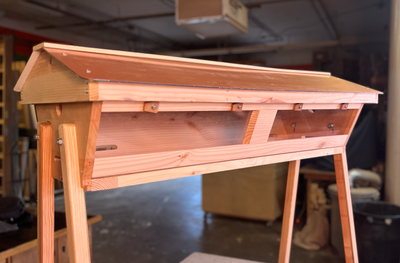The Mysterious Bee Escape
Few of our beekeeping supplies seem as perplexing to new beekeepers as the bee escape. On its own, the yellow plastic bee escape hardly looks intuitive (is it a hummingbird feeder? A water trough? A Frisbee?). Once mounted to a Langstroth inner cover or other similar board with a 2" opening, however, the bee escape board becomes a beautifully simple honey-harvesting tool.
 Also known as a "cleaner board", the bee escape board solves a basic beekeeping challenge: how to remove bees clustered on the honeycomb you want to harvest? Areas of the hive that contain honey will also contain thousands of bees performing myriad tasks. Before a beekeeper can harvest, they must gently remove these loyal workers. Rather than pull combs one at a time and brush off bees, only to watch them land on the comb again, the bee escape allows you to remove bees from your honeycomb without disturbing the colony. There are several models of bee escapes; we carry an 8-way model (above left) that works with multiple hive types, but the triangular style (above right) is common and effective as well.
Also known as a "cleaner board", the bee escape board solves a basic beekeeping challenge: how to remove bees clustered on the honeycomb you want to harvest? Areas of the hive that contain honey will also contain thousands of bees performing myriad tasks. Before a beekeeper can harvest, they must gently remove these loyal workers. Rather than pull combs one at a time and brush off bees, only to watch them land on the comb again, the bee escape allows you to remove bees from your honeycomb without disturbing the colony. There are several models of bee escapes; we carry an 8-way model (above left) that works with multiple hive types, but the triangular style (above right) is common and effective as well. Acting as a one-way gate between boxes of your hive, the bee escape allows workers to leave a "honey super" and return to the brood nest during the night. In the morning, the board's tiny maze foils their attempts to reenter the box. Place a bee escape below your box of honeycomb 24-48 hours before you plan to harvest honey, with the maze side facing away from the honey. Ideally you'll return to find a mostly empty box. Bees return the brood nest during the evening to stay warm as nighttime temperatures drop, so the effectiveness of bee escapes partially depend on cold evenings. Beekeepers in areas with warm, humid nights may need the full 48 hours to clear out a box; even then, you might need to brush off some stragglers
Acting as a one-way gate between boxes of your hive, the bee escape allows workers to leave a "honey super" and return to the brood nest during the night. In the morning, the board's tiny maze foils their attempts to reenter the box. Place a bee escape below your box of honeycomb 24-48 hours before you plan to harvest honey, with the maze side facing away from the honey. Ideally you'll return to find a mostly empty box. Bees return the brood nest during the evening to stay warm as nighttime temperatures drop, so the effectiveness of bee escapes partially depend on cold evenings. Beekeepers in areas with warm, humid nights may need the full 48 hours to clear out a box; even then, you might need to brush off some stragglers
 So far we've focused on using a bee escape board in a Langstroth hive, but they can be handy for Warre and Kenyan top bar hives. Using your bee escape in a Warre hive will be almost identical to using in a Langstorth, but you'll need to improvise a board for mounting the escape. You can cut a "C" shaped flap in your separator canvas and lay it over the bee escape, ensuring the bees will pass through the escape rather than around it. If you're feeling crafty you can make a more permanent board by drilling a 2" hole in a 14"x14" sheet of wood or other solid material. Using a bee escape in a Kenyan top bar hive is a little trickier. Although you could theoretically mount a bee escape to a follower board with a hole drilled through, we usually think it's easier to brush bees off honeycomb and seal it up immediately in a closed bucket.
So far we've focused on using a bee escape board in a Langstroth hive, but they can be handy for Warre and Kenyan top bar hives. Using your bee escape in a Warre hive will be almost identical to using in a Langstorth, but you'll need to improvise a board for mounting the escape. You can cut a "C" shaped flap in your separator canvas and lay it over the bee escape, ensuring the bees will pass through the escape rather than around it. If you're feeling crafty you can make a more permanent board by drilling a 2" hole in a 14"x14" sheet of wood or other solid material. Using a bee escape in a Kenyan top bar hive is a little trickier. Although you could theoretically mount a bee escape to a follower board with a hole drilled through, we usually think it's easier to brush bees off honeycomb and seal it up immediately in a closed bucket.-If you've created a top entrance for you hive, make sure it's blocked up. A second entrance allows workers to sneak back in and renders the bee escape ineffective.
Happy Harvesting!





